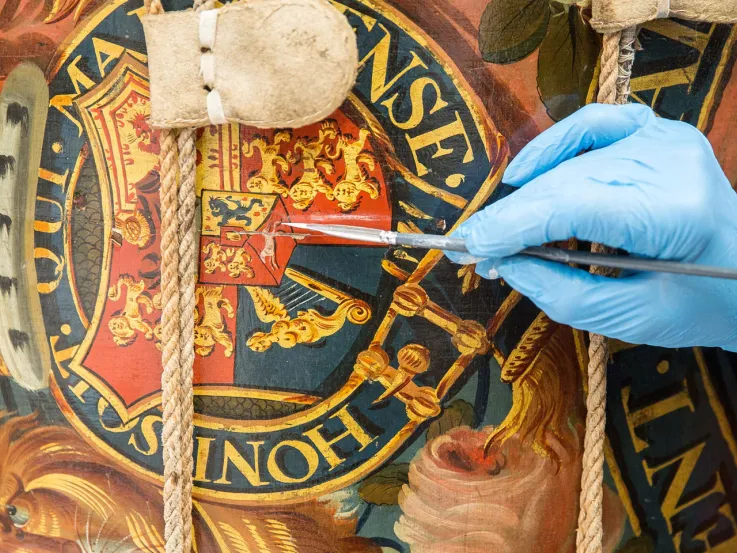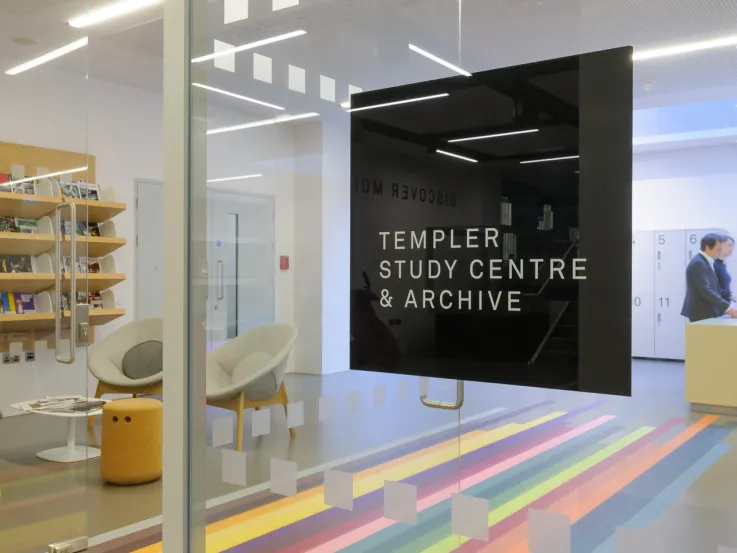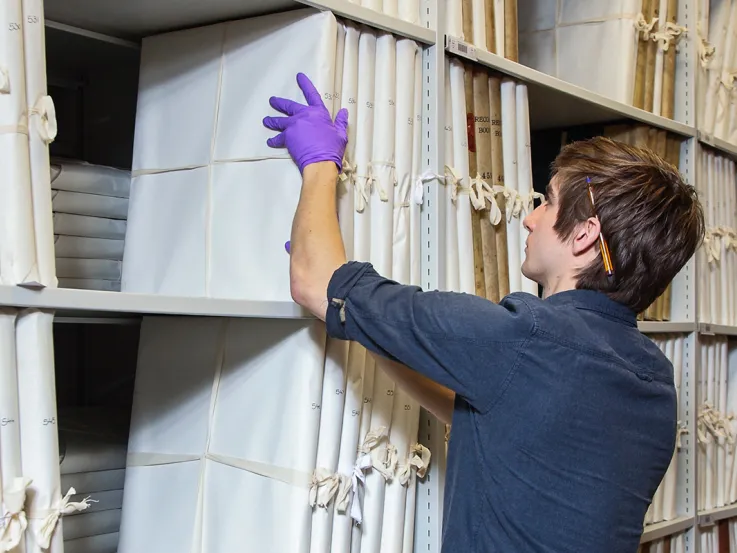How to research a former soldier
Family history
The National Army Museum does not hold soldiers' personnel records or service papers. Therefore, it is unlikely that anything in our collections can give you definitive answers regarding the service of an individual soldier.
We may hold personal items relating to that soldier, or their regiment, within our collections. These can be searched on our website via our Online Inventory. However, your best starting point is to search for a surviving service record.
Researching a former soldier requires piecing together information from a variety of different sources and is dependent upon surviving records. For some soldiers, little to no information is available. The guidance below outlines the most appropriate places to look.
The availability of records containing information on a former soldier is contingent upon many factors. The most important being:
- whether they were an officer or an ‘other rank’ (i.e. a private soldier or non-commissioned officer)
- the period in which they served
- whether they served in the British Army or one of Britain’s colonial forces.
If you know which regiment or corps the soldier served with, we also recommend checking for any records held by the relevant regimental or corps museum. Their contact details can be found on the Army Museums Ogilby Trust website. Please note that regimental museums do not hold personnel records or service papers.
Records held by The National Archives
The National Archives at Kew are the repository for soldiers' personnel records. They currently hold records of individuals with a date of birth before and up to 1 January 1939. Their catalogue can be searched on the Discovery section on their website.
Many military records held by The National Archives (and several other institutions) have been digitised and are available to view on Findmypast and Ancestry. Please note that both of these websites charge a fee to view records.
British soldiers until 1920
Pre-First World War
Researching an officer
The National Archives have a research guide for British Army officers up to 1913 on their website. Officers' service records are held under the references WO 25 and WO 76 and they can be searched by name. Alternatively, you can browse WO 25 and WO 76 by regiment on their catalogue.
Birth, marriage and death certificates of officers’ children from 1755 to 1908 are held in WO 42. They can be searched on Ancestry or browsed manually on the catalogue.
Widows’ pensions, half pay and disability pensions from 1755 to 1816 and 1815 to 1856 are kept in WO 25/3995 and WO 25/3069-3072.
Registers of cadets who attended the Royal Military Academy Woolwich, Royal Military Academy Sandhurst, and the Royal Military College from 1790 to 1946 are available to view on the website of The Sandhurst Collection.
Researching other ranks
The National Archives have a research guide for British Army soldiers up to 1913 on their website. Self-contained service records do not exist for other ranks before the First World War. Therefore, a soldier’s service must be constructed using a mixture of records.
Royal Hospital Chelsea soldier service records for men who were discharged and received a pension from 1760 to 1913 are kept in WO 97. The Royal Hospital Chelsea admission books, registers and other papers from 1702 to 1933 are held in WO 23. Other pension records are held in WO 22, WO 121, WO 131, WO 117 and WO 122, and can also be browsed on The National Archives catalogue.
Many surviving British Army service, pension and discharge records from before the First World War have been digitised and can be viewed on Findmypast.
British Army muster rolls and paylists can also be used to trace the outline of a soldier’s service between c1730 and 1898. A full research guide can be found on The National Archives website.
First World War
To trace the service of soldiers from the First World War (or sometimes earlier), you must first determine whether their service record survives. Regrettably, more than half of the service records were damaged or destroyed during the Second World War, when a German bombing raid struck the War Office repository.
Researching an officer
The National Archives have a research guide for British Army officers of the First World War on their website. Although the majority of records were destroyed, The National Archives hold over 217,000 service records for British Army officers for the First World War. They are held in WO 339 and WO 374 and can browsed on their catalogue. The content of the files varies.
In the absence of a personnel record, you may wish to consult unit war diaries, medal index cards, medal roll cards, prisoner-of-war records, absent voters lists, regimental histories, and army lists to piece together the service of an individual officer.
Researching other ranks
The National Archives have a research guide for British Army soldiers of the First World War on their website. Many existing records held by The National Archives and other organisations have been digitised and are available to search on Findmypast and Ancestry. They contain records held in WO 363 and WO 364, which can also be browsed on The National Archives catalogue.
The Women’s Army Auxiliary Corps service records from 1917 to 1920 are also held at The National Archives in WO 398. These records can be browsed on their catalogue. They can also be searched on Findmypast and Ancestry. It is important to note that only around 7,000 out of 57,000 records survive.
For any soldiers who were taken prisoner during the First World War, there is likely to be an International Red Cross index card entry. All of these have now been digitised and can be searched via their website.
British soldiers since 1920
Ministry of Defence
The Ministry of Defence (MOD) is currently in the process of transferring 10 million soldier service records to The National Archives, with the process expected to be completed by the end of 2027. The collection includes the records of individuals with a date of birth before and up to 1 January 1939, with the vast majority being of those who served during the Second World War.
Due to the amount of personal data included in the records, they will typically remain closed until 115 years past the date of birth of the individual. For more information and FAQs about the project, please visit The National Archives website.
Service records for individuals in service since 1963 remain with the MOD and are only accessible to the service personnel themselves or their next of kin. Details on how to apply for access to personal data held by the MOD can be found on the Gov.uk website.
Second World War
Unlike records from the First World War, service records for individuals who served in the British Army during the Second World War survived in their entirety. However, while the transfer project is ongoing, only a small proportion are currently searchable on The National Archives catalogue.
Researching other ranks
The National Archives have a research guide for British Army soldiers of the Second World War on their website. Catalogued records can be searched via the search engine on the research guide and are held in WO 420, WO 421, WO 422, WO 423, and WO 427.
The records of women who served in Auxiliary Territorial Service (ATS) from 1938 to 1949 are also being transferred to The National Archives as part of the Ministry of Defence service records project.
If you are unable to find a service record after searching The National Archives catalogue, a Freedom of Information request can be submitted. There are three different kinds of form you can submit:
- Request your own record if you were born before or in 1939 (or if you are doing this on behalf of a living individual)
- Request military service records for a person born before 1909
- Request military service records for a person born between 1909 and 1939
British Army casualty lists for 1939 to 1945 are held in WO 417 and can also be searched on Findmypast.
The Red Cross holds records of prisoners taken during the Second World War. Details on how to enquire about these records can be found online.
Researching an officer in service after 1918
Officers' service records for the Second World War are currently held at the Ministry of Defence. The National Archives have a research guide for British Army officers in service after 1918 on their website.
Medal records, unit war diaries, recommendations for military honours and awards, gazette announcements, and casualty lists can also be used to research the service of a Second World War officer.
British soldiers’ effects, 1901-60
The National Army Museum holds the soldiers’ effects ledgers that were created by the War Office to record the monies owing to those who died while serving in the British Army. These records run from 1901 to 1960, covering the latter stages of the Boer War and, of course, both World Wars.
Typically, they contain the following details: name, rank, regiment, service number, date (and sometimes place) of death, name of the next of kin, and how much they received. They do not list any personal items, addresses or pension details. You can search the records for 1901-29 on Ancestry.
Soldiers in Irish regiments, 1920-22
The National Army Museum also holds the enlistment books of five Irish units of the British Army which were disbanded following the establishment of the Irish Free State in 1922.
They contain records of soldiers serving in the Connaught Rangers, the Leinster Regiment, the Royal Dublin Fusiliers, the Royal Irish Regiment and the Royal Munster Fusiliers between 1920 and 1922. You can search these records online.
Empire and Commonwealth soldiers
The National Archives hold some collections from the Colonial Office relating to soldiers who fought in the British Army. These carry a CO reference. However, after independence, former British colonies assumed responsibility for records relating to their armed forces. Therefore, most records are held by the various countries in question.
A research guide for soldiers in African forces under British Control is available on the website of The National Archives. It contains information on collections the archive holds relating to the King’s African Rifles (1897–1953), the Royal West African Frontier Force (1900–12), and the Royal African Corps (1800–40).
Some information about men who fought in the British West Indies Regiment are held in CO 318. And records for soldiers discharged to pension, including the British West Indies Regiment and the West India Regiment, may be found in WO 364. The National Archives has further advice on researching Colonial Office records online.
Service records for soldiers in the Dominion forces of Australia, Canada, New Zealand and South Africa can be found in their respective national archives. In the case of Australia, further records are held at the Australian War Memorial.
Indian Army Personnel
Records for soldiers in the Indian Army during British rule, including the East India Company Army, are held by the British Library. The index of 13,000 officers who served in the Indian Army from 1900 to 1947 can be searched on Findmypast. British India Office Army Pensions from 1749 to 1947 can also be searched on Findmypast.
The National Army Museum holds a card index begun by CVP Hodson, which contains brief biographical and service data on officers of the East India Company and British Indian Army up until 1947. This card index has been digitised and can be searched by name by National Army Museum staff upon request. Please note, the index is not available for the public to search online.
Commonwealth soldiers who died in the World Wars
The Commonwealth War Graves Commission (CWGC) holds records of the 1.7 million men and women of the Commonwealth who died in the World Wars, and maintains cemeteries and memorials for them. The CWGC website contains a searchable database of those recorded as lost.
Templer Study Centre
The Templer Study Centre provides access to the National Army Museum’s archive and library collections. While the Museum is not a repository for soldiers' personnel records, we may hold archival collections or books that can provide further context to a soldier’s army service. This is particularly true in the regimental collections held at the Museum, including the Coldstream Guards, the Grenadier Guards, the Middlesex Regiment, The Buffs, and the Women’s Royal Army Corps.
The Templer Study Centre also provides access to Army Lists from 1740 to 2005, including the Indian Army List, which can be used to trace the outline service career of a British Army officer.
How to submit an enquiry
If you have a question regarding the National Army Museum's collections, you can submit an enquiry through our contact form, by sending an email to info@nam.ac.uk, or by writing to:
Collections Enquiries
National Army Museum
Royal Hospital Road
London SW3 4HT
The National Army Museum does not have the capacity to respond to individual enquiries that are not directly related to the Museum’s collections. We continue to encourage enquirers to book to see our library and archive collections through the Templer Study Centre in Chelsea, or for our other collection types at our Collections Centre in Stevenage.



